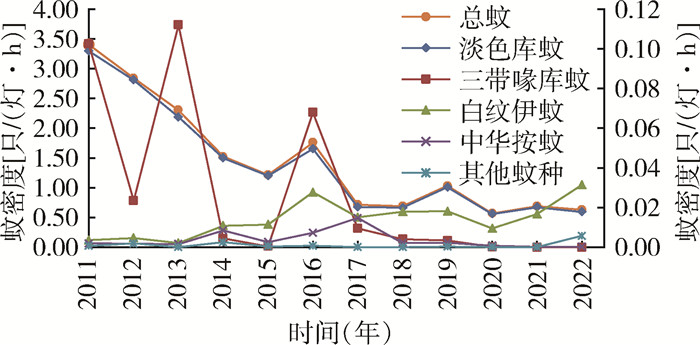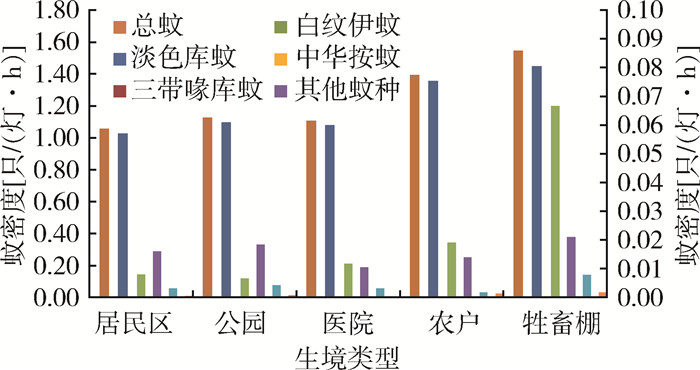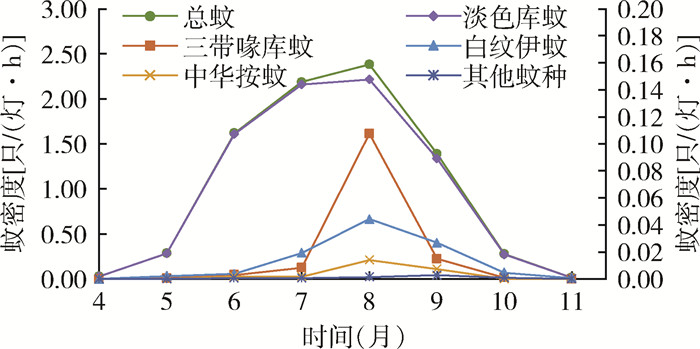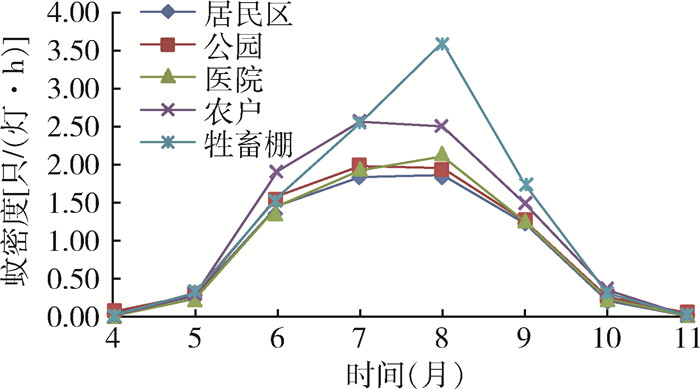| 1 |
刘起勇. 新时代媒介生物传染病形势及防控对策[J]. 中国媒介生物学及控制杂志, 2019, 30 (1):1-6, 11.
DOI
|
|
Liu QY. Epidemic profile of vector-borne diseases and vector control strategies in the new era[J]. Chin J Vector Biol Control, 2019, 30 (1):1-6, 11.
DOI
|
| 2 |
马丽华, 黄钢, 王喜明. 基于层次分析法的河北省病媒生物密度监测质量评价方法研究[J]. 中国媒介生物学及控制杂志, 2019, 30 (6):634-638, 660.
DOI
|
|
Ma LH, Huang G, Wang XM. A quality assessment method based on the analytic hierarchy process for vector density surveillance in Hebei province, China[J]. Chin J Vector Biol Control, 2019, 30 (6):634-638, 660.
DOI
|
| 3 |
王学军, 赵志刚, 刘峰, 等. 两种蚊虫密度监测方法实验室及现场诱蚊效果观察[J]. 中国媒介生物学及控制杂志, 2011, 22 (6):590-591, 594.
|
|
Wang XJ, Zhao ZG, Liu F, et al. Efficacy of two mosquito density monitoring methods in laboratory and field settings[J]. Chin J Vector Biol Control, 2011, 22 (6):590-591, 594.
|
| 4 |
张勇, 刘婷, 曾晓芃. 北京市2010-2012年蚊虫密度监测结果及变化趋势分析[J]. 中国媒介生物学及控制杂志, 2014, 25 (2):101-104.
DOI
|
|
Zhang Y, Liu T, Zeng XP. Analysis of surveillance results and trends of mosquito density in Beijing from 2010 to 2012[J]. Chin J Vector Biol Control, 2014, 25 (2):101-104.
DOI
|
| 5 |
高文, 马丽华, 黄钢, 等. 河北省2013-2015年蚊媒传染病与蚊密度相关性分析[J]. 中国媒介生物学及控制杂志, 2016, 27 (4):350-353.
DOI
|
|
Gao W, Ma LH, Huang G, et al. Analysis on correlation between mosquito-borne diseases and seasonality of mosquito density in Hebei province from 2013 to 2015[J]. Chin J Vector Biol Control, 2016, 27 (4):350-353.
DOI
|
| 6 |
郭玉红, 吴海霞, 刘小波, 等. 2018年全国媒介蚊虫监测报告[J]. 中国媒介生物学及控制杂志, 2019, 30 (2):128-133.
DOI
|
|
Guo YH, Wu HX, Liu XB, et al. National vectors surveillance report on mosquitoes in China, 2018[J]. Chin J Vector Biol Control, 2019, 30 (2):128-133.
DOI
|
| 7 |
陆润泽, 刘起勇, 吴海霞, 等. 2014年中国淡色库蚊/致倦库蚊种群地理分布特征分析[J]. 中国媒介生物学及控制杂志, 2016, 27 (2):107-111.
DOI
|
|
Lu RZ, Liu QY, Wu HX, et al. Zoogeographical analysis of Culex pipiens pallens/Cx. pipiens quinquefasciatus in China, 2014[J]. Chin J Vector Biol Control, 2016, 27 (2):107-111.
DOI
|
| 8 |
李治平, 吴照, 刘旭红, 等. 甘肃省2018年病媒生物监测报告[J]. 中国媒介生物学及控制杂志, 2019, 30 (6):639-642.
DOI
|
|
Li ZP, Wu Z, Liu XH, et al. A vector surveillance report of Gansu province, China, 2018[J]. Chin J Vector Biol Control, 2019, 30 (6):639-642.
DOI
|
| 9 |
丁俊, 王纯玉, 白玉银, 等. 辽宁省2014-2018年蚊虫密度与季节消长监测分析[J]. 中国媒介生物学及控制杂志, 2021, 32 (2):169-172.
DOI
|
|
Ding J, Wang CY, Bai YY, et al. Surveillance and analysis of mosquito density and seasonal fluctuation in Liaoning province, China, 2014-2018[J]. Chin J Vector Biol Control, 2021, 32 (2):169-172.
DOI
|
| 10 |
袁爽, 葛涛, 唐磊, 等. 黑龙江省病媒生物监测点2007-2017年蚊虫监测结果分析[J]. 中国媒介生物学及控制杂志, 2021, 32 (1):52-55.
DOI
|
|
Yuan S, Ge T, Tang L, et al. An analysis of mosquito surveillance results from vector surveillance sites in Heilongjiang province, China, 2007-2017[J]. Chin J Vector Biol Control, 2021, 32 (1):52-55.
DOI
|
| 11 |
唐振强, 樊金星, 刘吉起. 河南省2019年病媒生物监测报告[J]. 中国媒介生物学及控制杂志, 2020, 31 (6):706-709.
DOI
|
|
Tang ZQ, Fan JX, Liu JQ. A surveillance report of vectors in Henan province, China, 2019[J]. Chin J Vector Biol Control, 2020, 31 (6):706-709.
DOI
|
| 12 |
王巧燕, 王韶华, 武峥嵘, 等. 上海市嘉定区2018-2020年成蚊生态学监测研究[J]. 中国媒介生物学及控制杂志, 2022, 33 (3):346-350.
DOI
|
|
Wang QY, Wang SH, Wu ZR, et al. Ecological surveillance of adult mosquitoes in Jiading district, Shanghai from 2018 to 2020[J]. Chin J Vector Biol Control, 2022, 33 (3):346-350.
DOI
|
| 13 |
杨维芳, 张育富, 刘大鹏, 等. 江苏省2008-2018年蚊虫种群消长研究[J]. 中国媒介生物学及控制杂志, 2021, 32 (1):45-51.
DOI
|
|
Yang WF, Zhang YF, Liu DP, et al. A study of mosquito population variation in Jiangsu province, China, 2008-2018[J]. Chin J Vector Biol Control, 2021, 32 (1):45-51.
DOI
|
| 14 |
刘小波, 吴海霞, 殷文武, 等. 2006-2012年全国19省三带喙库蚊监测研究[J]. 疾病监测, 2014, 29 (4):281-286.
DOI
|
|
Liu XB, Wu HX, Yin WW, et al. Surveillance for Culex tritaeniorhynchus in China, 2006-2012[J]. Dis Surveill, 2014, 29 (4):281-286.
DOI
|
| 15 |
刘起勇. 气候变化对中国媒介生物传染病的影响及应对: 重大研究发现及未来研究建议[J]. 中国媒介生物学及控制杂志, 2021, 32 (1):1-11.
DOI
|
|
Liu QY. Impact of climate change on vector-borne diseases and related response strategies in China: Major research findings and recommendations for future research[J]. Chin J Vector Biol Control, 2021, 32 (1):1-11.
DOI
|
| 16 |
刘小波, 岳玉娟, 贾清臣, 等. 2020-2021年我国12省份媒介伊蚊生态学调查[J]. 中国媒介生物学及控制杂志, 2022, 33 (1):8-15.
DOI
|
|
Liu XB, Yue YJ, Jia QC, et al. Ecological investigation of Aedes vector in 12 provinces of China in 2020-2021[J]. Chin J Vector Biol Control, 2022, 33 (1):8-15.
DOI
|
| 17 |
孙钦同, 韩英男, 刘言, 等. 山东省登革热媒介白纹伊蚊生态学调查分析[J]. 中国媒介生物学及控制杂志, 2022, 33 (1):16-20.
DOI
|
|
Sun QT, Han YN, Liu Y, et al. Ecological investigation and analysis of Aedes albopictus, the vector of dengue fever, in Shandong province, China[J]. Chin J Vector Biol Control, 2022, 33 (1):16-20.
DOI
|
| 18 |
郭慧, 柳静, 毛伟平, 等. 武汉市2018-2021年媒介伊蚊生态学监测结果分析[J]. 中国媒介生物学及控制杂志, 2023, 34 (1):48-52.
DOI
|
|
Guo H, Liu J, Mao WP, et al. Ecological monitoring of Aedes vector in Wuhan, Hubei province, China, 2018-2021[J]. Chin J Vector Biol Control, 2023, 34 (1):48-52.
DOI
|










